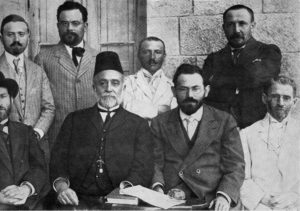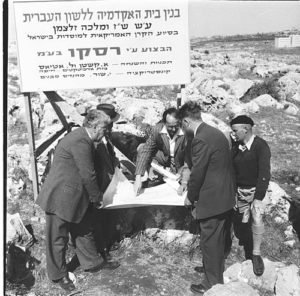History
Early Days of the Language Committee
 The first attempt to establish a language committee took place in 1889, when Eliezer Ben-Yehuda, in conjunction with the organization Safa Brura (Clear Speech; its goal was the advancement of Hebrew speech in the Yishuv), established a Jerusalem-based Literature Committee for the collection and publication of Hebrew words. The Committee was disbanded in 1891. Only after 14 years was the Language Committee established.
The first attempt to establish a language committee took place in 1889, when Eliezer Ben-Yehuda, in conjunction with the organization Safa Brura (Clear Speech; its goal was the advancement of Hebrew speech in the Yishuv), established a Jerusalem-based Literature Committee for the collection and publication of Hebrew words. The Committee was disbanded in 1891. Only after 14 years was the Language Committee established.
The main push for the foundation of the Language Committee in 1905 came from the Union of Teachers in the Land of Israel, which wanted to make Hebrew the language of instruction and common speech in schools. The teachers saw an immediate need for a governing body to guide language innovations and the creation of new terms for use by the teachers.
In 1905, the Language Committee was formed by Ben-Yehuda, David Yellin (1864-1941, teacher and researcher), Dr. Eliyahu Sapir (1869-1911, teacher), Dr. Aharon Meir Mazia (1858-1930, physician), Yehiel Michal Pines (1843-1913, rabbi and Zionist activist), and the Secretary Haim Ariye Zuta (1868-1939, teacher).
The early days were fraught with uncertainty and, in the opinion of the teachers’ union, a work pace that was far too conservative. By 1911, Ahad Ha’am (pen name of Asher Ginsberg, one of the leading Zionist thinkers) intervened and attempted to bestow authority over terminology to the Language Committee, but tension continued.
Eliezer Ben-Yehuda published several lists of the Language Committee’s terms in his newspapers. From 1912-1928 the public learned of its work through the publication of its minutes, lectures, discussions, and lists of words in the Zikhronot Va’ad HaLashon (the Minutes of the Language Committee). Among the issues discussed were the pronunciation of Modern Hebrew and the principles in establishing new Hebrew terms to replace foreign words. The first published words included lists of plant names, dress, food, furniture, and geography.
The Language Committee’s activities came to a halt during World War I and began again after the British conquest of the Holy Land. Other members were eventually added to the Language Committee, including educators, authors, and linguists. During this period, the Language Committee discussed the future of the organization and envisioned a place of study, scientific research, and innovation. Soon its name was temporarily changed to Midrash HaLashon (The Language Institute).
The Language Committee began negotiations with the British over the acknowledgement of Hebrew as an official language alongside Arabic. During these years, the idea of Hebrew as a common tongue underwent a substantial change in the Yishuv and it was now considered the national language of the Jewish settlement and its institutions. Though the Committee did not receive financial support from the Yishuv leadership, which remained a problem until the formal establishment of the Academy of the Hebrew Language, its scholars aided in answering questions and forming terms for the various Yishuv bodies.
Upon Ben-Yehuda’s death in 1922, the Committee suspended its activities. It restarted in 1924 when poet Haim Nachman Bialik made aliya and joined the Committee as its new president (alongside Yellin and Mazia). By 1926, the Committee’s efforts advanced and additional scholars were appointed, including editors and journalists, grammarians, researchers, and authors. Various sub-committees were formed in specific fields with grammarians working alongside professionals to create new viable Hebrew terms.
The quarterly publication, Leshonenu, was established in 1928, and many word lists and professional dictionaries were published: some 30,000 terms in 60 professions.
By the 1948 War of Independence, the Language Committee was active in several cities throughout the country and aided in the formation of governmental terms for the burgeoning state. During the war, however, when Jerusalem (the hub of activity) was isolated from the rest of the country, the work of the Language Committee slowed down substantially. This had a negative influence on the funding of the Language Committee since it had never been recognized as an official national body and received no financial support apart from a few private donations.
Foundation of the Academy
It was understood, even before the foundation of the state, that it was necessary to establish an officially recognized institute of Hebrew language. In October 1948, a preliminary committee was formed to prepare  the foundation for the Academy of the Hebrew Language as an official body for research and guidelines.
the foundation for the Academy of the Hebrew Language as an official body for research and guidelines.
By January 1949, the establishment of the Academy of the Hebrew Language was declared in the presence of Prime Minister, David Ben-Gurion, and was enacted into law in August 1953. The lag between establishment and the law was largely due to the name “Academia” or Academy. Ben-Gurion was against a foreign word as the name of the institution, but the members of the Committee stood firm. In the end it was explicitly stated in the law that the institution had the right to name itself.
The first 15 members were chosen in 1953 and the name “Ha’Akademia LaLashon Ha’Ivrit” (the Academy of the Hebrew Language) was chosen in the first meetings of the organization, along with the creation of its charter and goals:
- To gather and research Hebrew language vocabulary of all periods and levels
- To research the forms of Hebrew and its history
- To guide the natural development of the language according to the needs and possibilities in all fields, in vocabulary, grammar, writing, and transliteration.
Historic Cabinet Decision
4 Kislev 5773, 18 November 2012
In November 2012, in the midst of the Gaza conflict, the Cabinet approved the founding of a national Center for the Hebrew Language in Jerusalem. The new Center would house the Academy of the Hebrew Language and The Hebrew Museum –  the first ever museum devoted to the history of the Hebrew language. The Center will serve as an attraction for visitors from Israel and abroad, and as a national and cultural meeting point for both Israelis, Diaspora Jews and other lovers and students of Hebrew.
the first ever museum devoted to the history of the Hebrew language. The Center will serve as an attraction for visitors from Israel and abroad, and as a national and cultural meeting point for both Israelis, Diaspora Jews and other lovers and students of Hebrew.
The Academy of the Hebrew Language is charged with overseeing and guiding the founding of the Center. Academy president, Professor Moshe Bar-Asher, has been appointed chairperson of the project’s steering committee and will coordinate the overall effort in cooperation with the Office of the Prime Minister and other government offices, the Jerusalem municipality, the World Zionist Organization, and donors. In addition, the government has committed funds for planning the Center. The Jerusalem municipality and the World Zionist Organization will assist in funding the planning stage, as well.
Professor Bar-Asher, in thanking the Prime Minister and the Cabinet for their decision, noted that this places Israel among the ranks of other states that have set their national language at the center of their existence and culture. He recalled how David Ben-Gurion sat in on the Cabinet session that approved the founding of the Academy of the Hebrew Language in the middle of the War of Independence. Ben-Gurion stated that the Israeli government would take the time, particularly during the war, to address the status of Hebrew and to establish a home for the Hebrew language.
The Minister of Culture and Sport at the time, MK Limor Livnat, expressed approval of the government decision and noted that this government has already devoted attention and resources to strengthening the status of the Hebrew language.
The Cabinet’s decision to create a lasting center for the Hebrew language is a historic one, because of the unique history of the Hebrew language, especially in the past 120 years, and because of the living, effervescent nature of Hebrew now and in the future in the State of Israel.
Back to top





